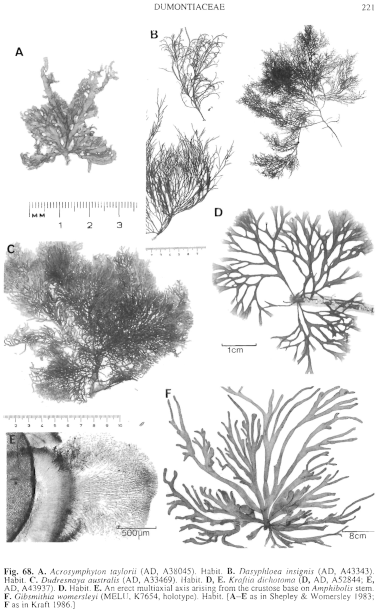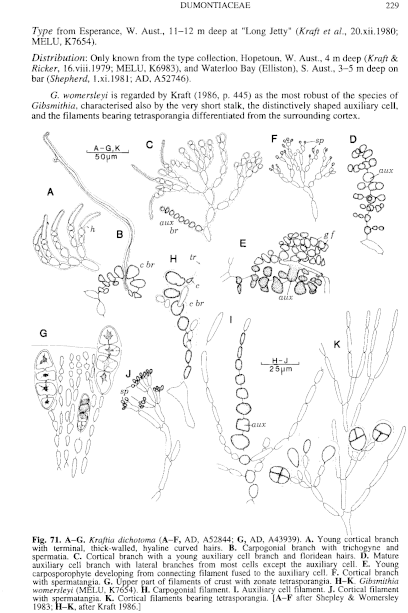|
|
|
|
|
|||||||||||
|
Electronic Flora of South Australia Species Fact Sheet
Phylum Rhodophyta – Class Florideophyceae – Order Gigartinales – Family Dumontiaceae
Thallus (Fig. 68D) erect, 1–3 cm high, subdichotomous, branches slightly compressed, 2–3 mm across near the base and tapering to about 1 mm in diameter near the rounded apices. Holdfast crustose, 1–4 mm across; epiphytic on Amphibolis. Structure multiaxial (Fig. 68E), with a filamentous medulla and a narrow, compact cortex, with the outer cortical cells bearing hyaline, thick-walled and terminally rounded hairs (Fig. 71A) bent towards the branch apex.
Reproduction: Sexual thalli monoecious, with carpogonial and auxiliary cell branches scattered in the outer medulla. Carpogonial branches (Fig. 71B) 9–12 cells long with the carpogonium sharply reflexed, cells 2 and 3 small and cells 4 and 5 larger and densely cytoplasmic, with post-fertilization fusion between the carpogonium and cell 4, resulting in an enlarged fusion cell producing several connecting filaments with basal pit-connections; lower cells of the carpogonial branch may bear single sterile cells laterally (Fig. 71B). Auxiliary cell branches (Fig. 71C, D) 9–14 cells long, with the auxiliary cell usually fourth or fifth from the apex and slightly laterally displaced, with all the cells below and often above the auxiliary cell forming short lateral branches. Carposporophytes (Fig. 71E) initially with 3–4 groups of gonimoblast cells, becoming globular (130–360 µm across) with most cells forming subspherical to ovoid carposporangia 10–13 µm in diameter, scattered in the outer medulla and not distending the cortex. Spermatangia (Fig. 71F) cut off from the outer cortical cells.
Tetrasporangia (Fig. 71G) terminal on filaments of a crustose pad on Amphibolis stems, ovoid, 25–36 µm long and 9–12 tun in diameter, zonately divided.
Type from Victor Harbor, S. Aust., 6 m deep (Clarke, 30.xii.1981); holotype in AD, A52844. Isotypes ("Marine Algae of southern Australia" No. 238) distributed to MEL, NSW, PERTH, UC, BM, PC, L, LD and other herbaria.
Selected specimens: Port Denison, W. Aust., drift (Kraft 4136, 14.xii.1971; AD, A50319). Venus Bay, S. Aust., drift (Womersley, 12.ii.1954; AD, A19501). Elliston, S. Aust., 7 m deep (Shepherd, 25.x.1971; AD, A42590). Tiparra reef, S. Aust., 5 m deep (Shepherd, 10.xii.1973; AD, A44596) and 11 m deep (Shepherd, 23.xii.1970; AD, A38254). Port Victoria, S. Aust., 3–4 m deep (Kraft, 20.ix.1973; AD, A44547). Stenhouse Bay, S. Aust., 3–7 m deep (Kraft, 18.ix.1973; AD, A44561). D'Estrees Bay, Kangaroo I., S. Aust., drift (Kraft, 16.i.1974; AD, A45064). Victor Harbor, S. Aust., 5–7 m deep (Clarke, 23.xii.1981; AD, A52822). Robe, S. Aust., 1–2 m deep near jetty (Mitchell, 16.ii.1974; AD, A44664 -"Marine Algae of southern Australia" No. 238a) and upper sublittoral near jetty, crust with tetrasporangia (Womersley, 26.viii.1973; AD, A43937, A43939). Queenscliff, Vic., drift (Norris, 21.i.1963; AD, A27481). Cats Bay, Phillip I., Vic. (Norris, 20.i.1963; AD, A27482). Walkerville, Vic., drift (Sinkora A2259, 2.iii.1976; AD, A48514).
Distribution: Port Denison, W. Aust. to Walkerville, Vic., always on lower stems of Amphibolis (A. antarctica and A. griffithii).
Taxonomic notes: Kraftia dichotoma occurs on Amphibolis, probably anywhere within the distribution of this seagrass, in areas of moderate water movement. It is usually confined to the lower stems in lower light intensity within the leafy canopy. Only one tetrasporangial field-collected specimen is known, but M.D. Guiry has shown that carpospores germinate to crustose tetrasporophytes (pers. comm. G.T. Kraft).
References:
SHEPLEY, E.A. & WOMERSLEY, H.B.S. (1983). The Dumontiaceae (Cryptonemiales: Rhodophyta) of southern Australia. Trans. R. Soc. S. Aust. 107, 201–217.
The Marine Benthic Flora of Southern Australia Part IIIA complete list of references.
Publication:
Womersley, H.B.S. (14 January, 1994)
The Marine Benthic Flora of Southern Australia
Rhodophyta. Part IIIA, Bangiophyceae and Florideophyceae (to Gigartinales)
Reproduced with permission from The Marine Benthic Flora of Southern Australia Part IIIA 1994, by H.B.S. Womersley. Australian Biological Resources Study, Canberra. Copyright Commonwealth of Australia.
Illustrations in Womersley Part IIIA, 1994: FIGS 68D, E, 71 A–G.

Figure 68 enlarge
Fig. 68. A. Acrosymphyton taylorii (AD, A38045). Habit. B. Dasyphloea insignis (AD, A43343). Habit. C. Dudresnaya australis (AD, A33469). Habit. D, E. Kraftia dichotoma (D, AD, A52844; E, AD, A43937). D. Habit. E. An erect multiaxial axis arising from the crustose base on Amphibolis stem. F. Gibsmithia womersleyi (MELU, K7654, holotype). Habit. [A–E as in Shepley & Womersley 1983; F as in Kraft 1986.]

Figure 71 enlarge
Fig. 71. A–G. Kraftia dichotoma (A–F, AD, A52844; G, AD, A43939). A. Young cortical branch with terminal, thick-walled, hyaline curved hairs. B. Carpogonial branch with trichogyne and spermatia. C. Cortical branch with a young auxiliary cell branch and floridean hairs. D. Mature auxiliary cell branch with lateral branches from most cells except the auxiliary cell. E. Young carposporophyte developing from connecting filament fused to the auxiliary cell. F. Cortical branch with spermatangia. G. Upper part of filaments of crust with zonate tetrasporangia. H–K. Gibsmithia womersleyi (MELU, K7654). H. Carpogonial filament. I. Auxiliary cell filament. J. Cortical filament with spermatangia. K. Cortical filaments bearing tetrasporangia. [A–F after Shepley & Womersley 1983; H–K, after Kraft 1986.]

|
Email Contact: State Herbarium of South Australia |

|